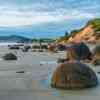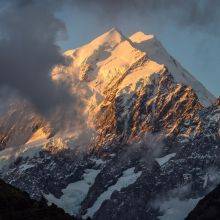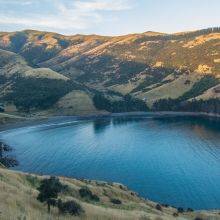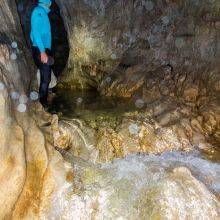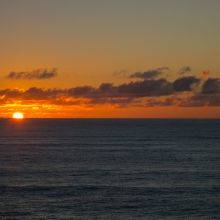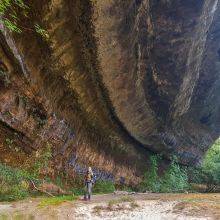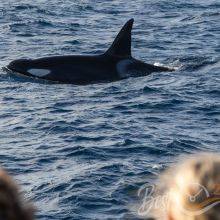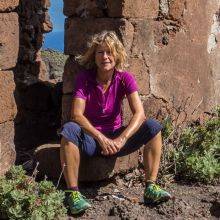When Is the Best Time
The unique geological Moeraki Boulders at the Otago Coast, located between Oamaru and Dunedin, are definitely worth a detour and a fantastic photo stop. Usually, the beach is crowded with day visitors. Tour buses pass by throughout the day. You can only see half of the boulders during high tide, and the beach is pretty small to walk along. To experience the magic of the boulders, plan to stay nearby for a night.

The best time for the Moeraki Boulders is between one hour before and after low tide. Regarding the crowds, early morning and evening are tranquil to soak in the jaw-dropping scenery. The very best hours for stunning pictures are during sunrise at low tide; the reason that we spent a night on the campground. The next morning, we shared the beach with a view passionate photographer only. Tide times + sunrise and sunset times at the Moeraki Boulders.
Parking Moeraki Boulders
You can park in front of the Moeraki Boulders Café (Google Maps) if it is not too busy. However, there is a second car park within walking distance. The Café offers indoor and outdoor seating with a yummy breakfast and lunch. Enjoy the sun and a spectacular view of the boulders from the terrace. A gift shop also offers souvenirs, ice, snacks, and information about the Moeraki Boulders.
Weather Otago Coast and Crowds at Moeraki
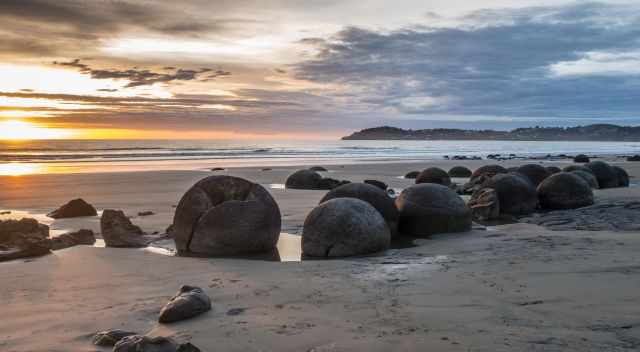
Rain occurs throughout the year though summer has the highest amount of precipitation. Even in the rain, the Moeraki Boulders at Koekohe Beach are fascinating. However, New Zealand also experiences lots of sunshine hours. The climate is mild usually, neither hot nor minus degrees.
Spring (September-November)

September and October are still cold, with day temps between 9°C-14°C. November starts to warm up with pleasant temperatures on average up to 16°C but can also be warmer. Night temps are below 10°C. The shoulder season, especially November, is a great time to visit NZ before it gets crowded.
Summer (December-February)

During summer, the average day temps are below 20°C, but warmer days with lots of sunshine occur as well. However, the sea temperature is too cold for a bath for most people, just around 13°C. Even in the summer, nights are chilly, with temps around 12°-14°C. Moeraki Beach and Boulders are packed with day visitors. Lots of tour buses make a stop here. Early morning between 6 and 8 am, and late evening are less busy and quieter. The Christmas break is the worst time when the Kiwis travel as well.
Autumn (March-May)
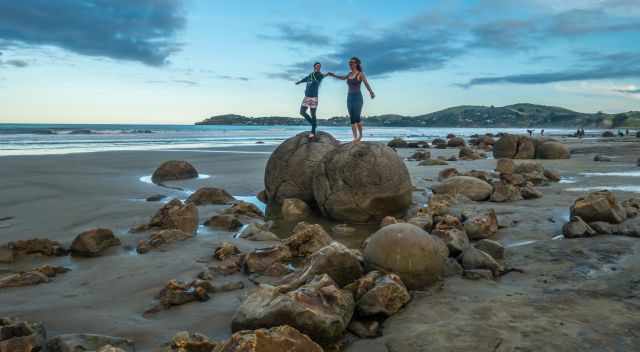
In March and April, temps are still bearable ranging from 12°C to 18°C. Decreasing rainfall from April onwards. The crowds thin out in autumn, and more accommodations are available.
Winter (June-August)

The South Island of NZ is drier in the winter with clear blue skies and colder temperatures ranging from 6°-10°C. Snow occurs in the Southern Alps and the Central Plateau on high elevation only. It’s the low season in NZ; accommodation prices are cheaper.
There are just a few accommodations close to the Moeraki Boulders. It is advisable to book your stay in advance from November to March/April; in the peak and shoulder season.
- Moeraki Boulders Holiday Park & Motel
We chose the Holiday Park for camping because all nearby accommodations were fully booked in March. The campground is well-equipped and clean. There are a camp kitchen and even a living room for their guests. They also offer nice and clean huts and campervan sites next to the sea. You can walk from the campground to the Moeraki Boulders during low tide. - Moeraki Boulders Motel
The motel is four minutes north of the Moeraki Boulders located. They offer clean and spacious rooms with basic cooking equipment. The owners are lovely, and the staff is super friendly. The comfy beds have electric blankets, which I greatly appreciate, even in the summer. Nights are cool on the South Island. - Moeraki Beach Motels
This motel is just five km south of the Moeraki Boulders located. It is quiet here, with private beach access. From the bedroom, you overlook the sea. The rooms are equipped with a kitchenette though there are restaurants within walking distance. It is also close to Katiki Point to spot seals and penguins. - Noah's Boutique Accommodation Moeraki
It is the closest accommodation to the Moeraki Boulders, just a three minutes drive. They offer self-contained studios with an outside seating area. It’s a quiet place close to the beach. The beds are comfy and equipped with an electric blanket. Leonie, your host, goes above and beyond to accommodate you.
These are my recommended tours via GetYourGuide. Thx for booking via my website! With your support, I am able to provide all information first-hand. Tour prices are at no extra cost!
Best Months to Visit
Location and Tips

These mysterious Moeraki Boulders featured in the Chronicles of Narnia “Voyage of the Dawn Treader” The remarkable boulders are located on the south island of New Zealand, just half an hour drive from Oamaru and one hour from Dunedin.
Are the Moeraki Boulders Worth a Visit or Detour?
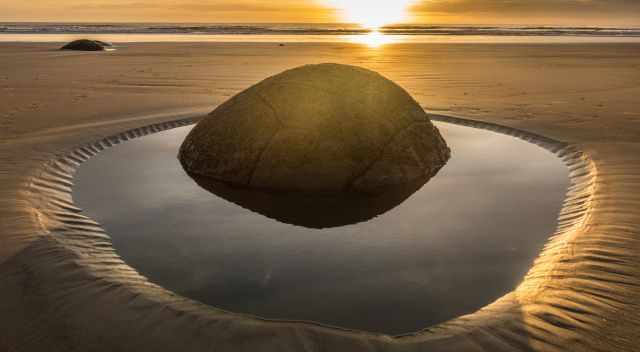
Yes, this unspoiled beach is definitely worth a detour. We visited the beach four times, and it was always different. Feel the magical atmosphere early morning or late in the day. Even if you can’t venture down, the view from the terrace of the café and at the beginning of the wooden staircase is awesome.
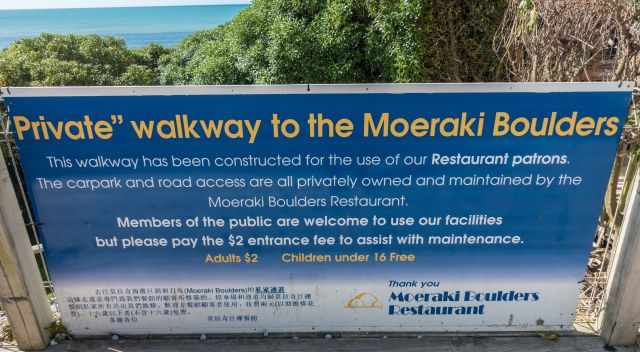
Free access to the beach but there is an honest box to pay 2$ for your visit and the use of the wooden staircase.
7 Facts and Geology About the Moeraki Boulders Formation
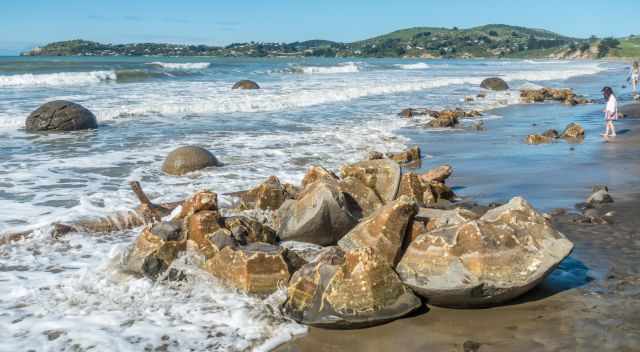
- More than 50 boulders can be found on Koekohe Beach.
- Smaller boulders were taken away before the beach, and boulders got protected.
- The diameter of the largest boulder is 2.2 meters.
- More than 65% measure over 1 meter in diameter.
- The estimated weight of the biggest boulders is roughly seven tons.
- The boulders were buried in mudstone cliffs behind the beach. Due to the massive power of the sea and the rainfall, these cliffs have already eroded for millions of years. The soft mudstone gets washed away, the cliffs break off, and left are the boulders at the beach. The process still continues, and more boulders will be exposed in the future. A long chemical process of more than 60 million years formed the boulders. It is estimated that it took another four million years to form huge boulders with more than two meters. The cementing mineral calcite slowly crystallized around organic nuclei in the sea. The surface became hard, and inside, the material began to dehydrate. This caused shrinkage cracks from the core to the surface. The cracks became filled with brown and yellow calcite crystals. These boulders have a hard mass like concrete. However, one day the boulders break off. By the time the region was lifted above the sea, new land masses were developed. This period of mountain building is still continuing.
- In some of the boulders are bones of extinct marine reptiles encapsulated. These boulders are south of Moeraki at Katiki Beach, Shag Point (scroll down to 3 Things to See and Do Nearby)).

The Maori Legend
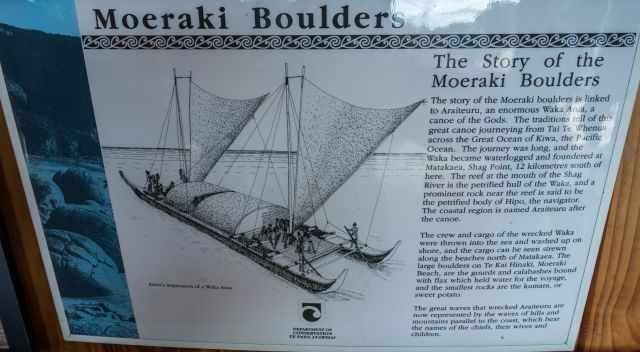
The Moeraki Boulders are the left cargo; round food baskets and calabashes filled with water of the great canoe Arai Te Uru called "Waka". The canoe sunk near Shag Point during a storm.
What does Moeraki Boulders mean? "drowsy or sleepy day" - It's an old Maori resting place.
3 Things to See and Do Nearby
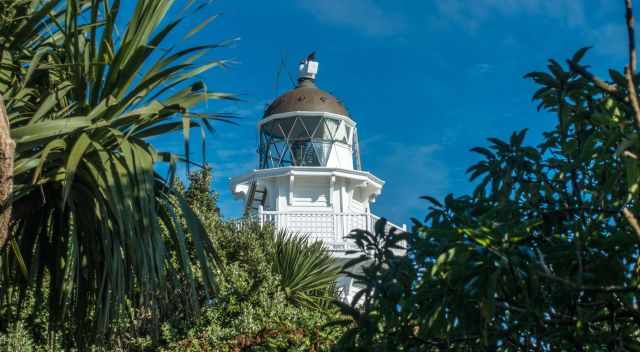
There is more to explore around Moeraki. Another reason why I recommend staying here at least one night better two.
- Visit the Katiki Point and Lighthouse to spot plenty of seals and yellow-eyed penguins. It’s a beautiful peninsula where we spent half a day. The last five km are gravel but suitable for 2WD. Free entrance
- Another fantastic spot but less busy for those fascinating boulders is Shag Point also free entrance (Google Maps Location)
- Watch the Oamaru blue penguins when they come back to their nests in the evening.
Contact me if you wish to use any of my photos, but I will take action against picture theft.





























